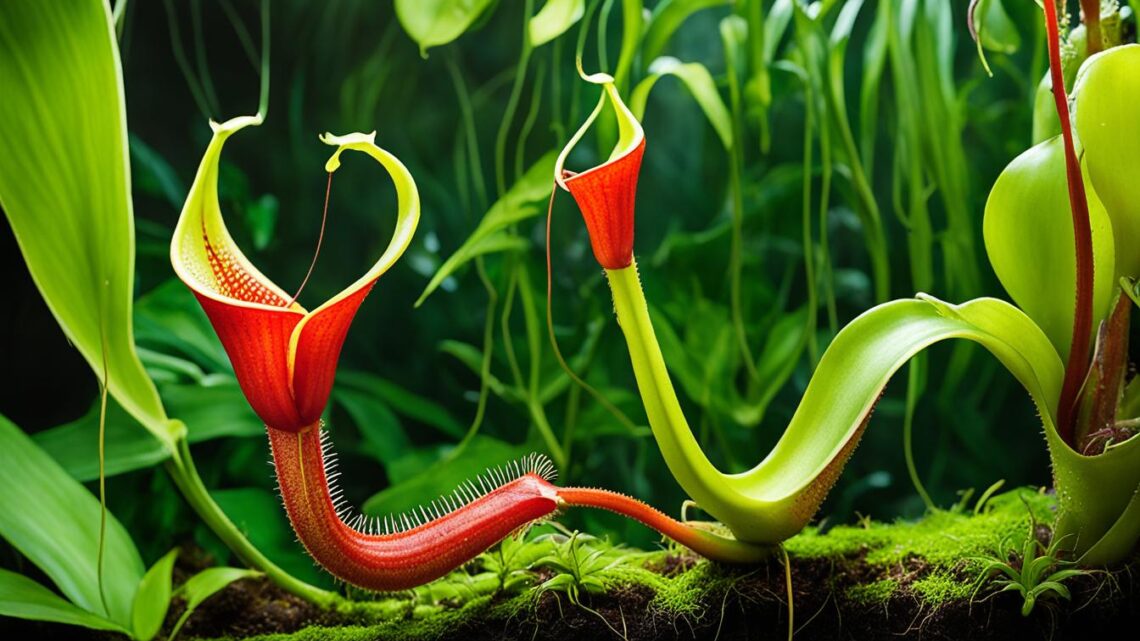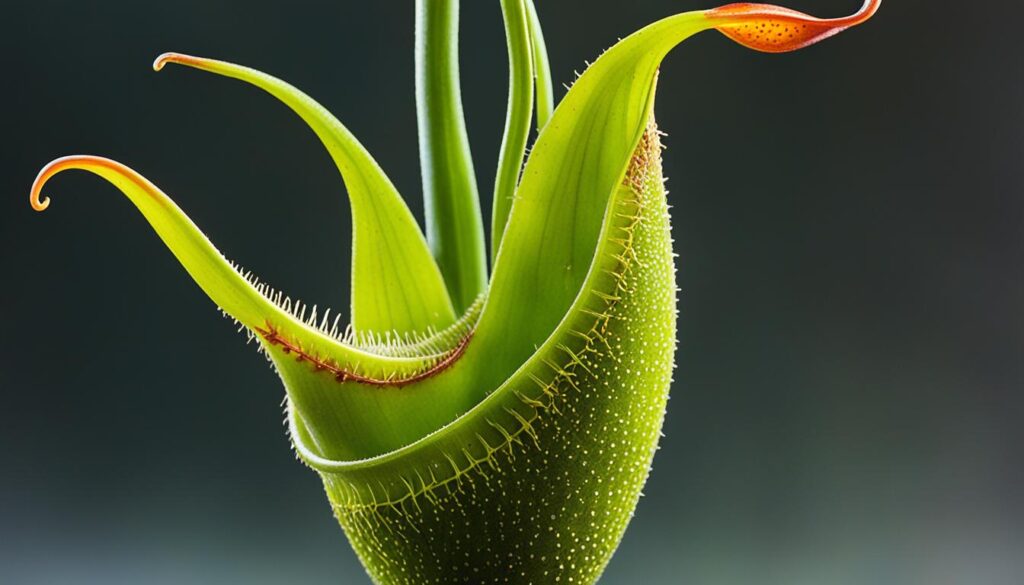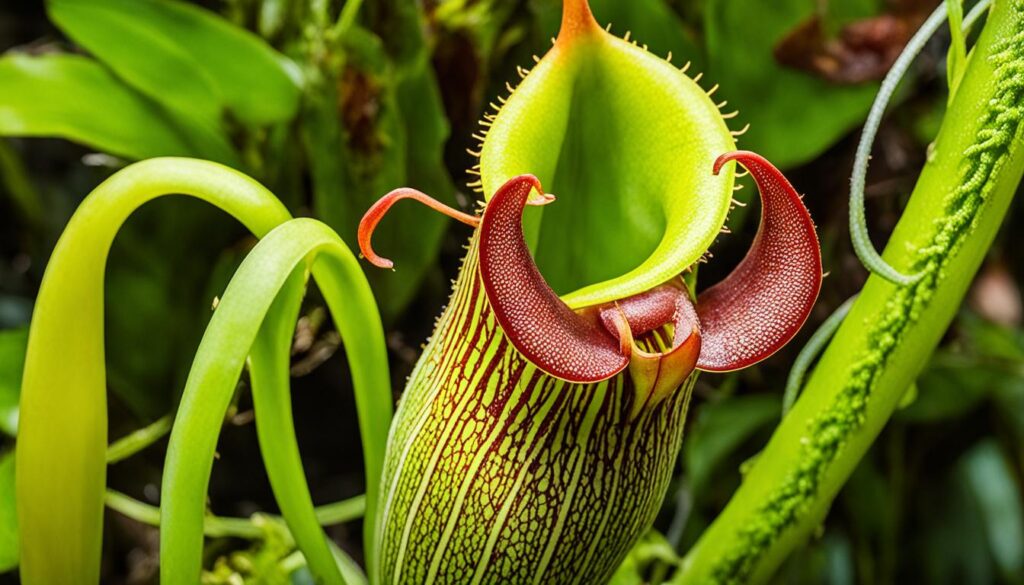
Have you ever seen a plant that acts like both a hunter and a friend? Enter Nepenthes bicalcarata, or the two-spurred pitcher plant. It is found in Borneo’s rich rainforests. This plant, nicknamed the «fanged pitcher plant» or «monkey cup,» is special. It has features that make it different from other meat-eating plants. Now, let’s explore what makes the Nepenthes bicalcarata unique and successful in Borneo.
Botanical Curiosity: Nepenthes bicalcarata
Nepenthes bicalcarata is a stunning carnivorous plant that catches the eye of both botanists and fans. It comes from the Nepenthaceae family. This family is famous for its meat-eating plants with unique traits and names.
Unique Features and Classification
One big thing that stands out about Nepenthes bicalcarata is its two big spines on the pitcher’s lid. With these fangs, it got its name «bicalcarata.» These spines are unique to this plant. They help it stand out in the Nepenthes group.
As a Nepenthes family member, N. bicalcarata is a carnivorous plant. This plant has a special way to catch and eat bugs. It uses its pitchers full of liquid to get extra food.
| Key Features of Nepenthes bicalcarata | Description |
|---|---|
| Pitcher Lid Spines | Two prominent, saber-toothed fangs hanging from the pitcher lid |
| Plant Classification | Member of the Nepenthaceae family, a genus of carnivorous pitcher plants |
| Habitat | Endemic to the island of Borneo, found in peat swamps and kerangas forests |
| Prey Capture | Uses its fanged pitcher to trap and digest insects and other small invertebrates |

The mix of its special look and its place in the Nepenthes group truly make Nepenthes bicalcarata special. It’s a plant that grabs the attention of anyone interested in plants or studies them.
The Fanged Pitcher Plant: A Striking Appearance
The Nepenthes bicalcarata, dubbed the «fanged pitcher plant,» has a unique, eye-catching look. It stands out within the Nepenthes genus. This is thanks to the thorns that look like walrus teeth, on its pitcher-shaped traps.
These thorns are up to 3 centimeters long. They not only add to its distinct appearance. They also help the plant catch insects for food by acting as a trap.
The shape and size of the thorns, along with the pitcher’s design, make the Nepenthes bicalcarata truly stand out. Plant lovers and scientists find this «fanged pitcher plant» very interesting. It draws attention with its unique and alien-like beauty.
| Characteristic | Description |
|---|---|
| Pitcher Lid Thorns | Prominent, walrus-tooth-like spines or thorns that can grow up to 3 cm (1.2 in) in length |
| Pitcher Shape | Distinctive pitcher-shaped traps that are part of the carnivorous adaptations |
| Botanical Curiosity | The unique appearance of the Nepenthes bicalcarata captivates plant enthusiasts and naturalists |

The Nepenthes bicalcarata really shows off the amazing variety in the Nepenthes genus. Its fearsome appearance and unique features keep drawing in plant lovers, conservationists, and nature fans. It’s truly unforgettable.
Endemic to Borneo: Habitat and Distribution
The Nepenthes bicalcarata, or Bornean pitcher plant, is found only on Borneo. It lives in the island’s many ecosystems. You can see this unique plant in the peat swamp forests on the island’s west coast.
This plant also grows in kerangas forests and white sand heaths. It usually grows under the dipterocarp tree, Shorea albida in peat swamp forests.
Peat Swamps and Kerangas Forests
Borneo is famous for its rich flora. It’s home to the Nepenthes bicalcarata in its peat swamp and kerangas forests. These forests have soils that lack nutrients and are acidic. This has led to special adaptations in the plants there.
The peat swamp forests have a lot of water and dead organic matter. This makes it hard for plants and animals to live there. The kerangas forests have sandy, poor soils. However, they support plants that can grow in these tough conditions.
Nepenthes bicalcarata is unique with its two-spurred pitchers. It shows how diverse and adaptable plants in Borneo can be.
Giant Among Nepenthes: Dimensions and Growth
The Nepenthes bicalcarata, or two-spurred pitcher plant, is the largest in its genus. It can climb up to 20 meters high, towering over others. This makes it truly giant in comparison. Also, its stems are thick, up to 3.5 centimeters in width.
The Nepenthes bicalcarata’s climbing prowess and massive leaves help it in the tropical forests. Its leaves can be 80 centimeters long and 12 centimeters wide. They have a tough texture and a slightly decurrent stem. These help the plant get a lot of sunlight and catch prey in its pitchers.
About 140 Nepenthes species exist, with most in Borneo and Sumatra’s forests. These plants grow in various altitudes, even up to 2,500 meters high. As they grow, Nepenthes pass through stages that decide their final height. This is why the Nepenthes bicalcarata truly stands out.
Nepenthes are dioecious, with male and female parts on different plants. This rare feature adds to their unique qualities. Besides their size, Nepenthes are famous for trapping prey, like ants, in various ways.
Vulnerable Species: Conservation Status
The Nepenthes bicalcarata, sometimes known as the two-spurred pitcher plant, is in a tough spot. It’s marked as Vulnerable on the IUCN Red List of Threatened Species. This means that, as of 2000, it’s facing threats in its home in Borneo.
One big issue is the loss and damage of its home. This happens because of deforestation and changes in how the land is used. The lands it calls home, like peat swamps and kerangas forests, are getting hurt by what people do. This endangers the future of this special meat-eating plant.
- Nepenthes bicalcarata can climb up to 20 meters into the forest canopy, with a cylindrical stem up to 3.5 cm in diameter and internodes up to 40 cm long.
- The large, leathery leaves of N. bicalcarata can grow up to 80 cm in length and 12 cm in width, and the pitchers may exceed one liter in volume, reaching 25 cm in height and 16 cm in width.
- The species is characterized by its distinctive, flattened and curved peristome (lip) that can be up to 20 mm wide, with the inner portion accounting for around 70% of the total cross-sectional surface length and bearing small but distinct teeth.
- The two sharp, horn-like spines on the underside of the pitcher lid, for which N. bicalcarata is named, can be up to 3 cm long.
It’s key to keep the peat swamp and kerangas forests safe for Nepenthes bicalcarata. This is vital to protect this plant for the future. Because it’s a vulnerable species, we need to act to save its delicate home. This way, this unique carnivorous plant can live on for many years.
Mutualistic Association: The Ant-Plant Relationship
The Nepenthes bicalcarata, or the two-spurred pitcher plant, has a special bond with the ant species Camponotus schmitzi. This unique connection is because of the plant’s special tendrils. They are hollow and swollen, creating perfect nests for the ants. The plant gives the ants a place to live. In return, the ants help the plant by carrying its seeds, protecting it, and even gathering nutrients the plant needs.
Camponotus schmitzi and Hollow Tendrils
The Camponotus schmitzi ants are very important to Nepenthes bicalcarata’s world. They love to live in the plant’s tendrils. This is good for both the plant and the ants. The ants bring nutrients to the plant by living there.
- With Camponotus schmitzi around, the plants show they get all their nitrogen from insects. This is different from plants without the ants, which only get 77% of their nitrogen from bugs.
- Adult plants get a lot more nitrogen from their leaves when the ants are around. They get 42% of this nitrogen from ant waste, but up to 76% if the plants have a lot of ants.
- Plants with ants make more leaves with more nitrogen. This helps the plant grow better and be stronger.
The partnership between Nepenthes bicalcarata and Camponotus schmitzi ants shows us how complex nature is. This close relationship benefits both sides a lot.
Carnivorous Adaptations: Pitcher Morphology
The Nepenthes bicalcarata plant has a special relationship with ants but it’s still a big hunter. Its pitchers have features that make them perfect for catching bugs. These include thorns and a special rim for trapping prey.
Thorns, Peristome, and Prey Capture
Nepenthes bicalcarata has thorns on its pitcher lid. These thorns help trick insects to fall off the lid. Once in the pitcher, insects are trapped and become the plant’s meal.
A wet pitcher rim, or peristome, is great at catching insects. This special design of Nepenthes bicalcarata helps ensure that insects get stuck.
The pitcher plant’s features, like thorns and peristome, are uniquely designed. They show how well it captures, traps, and eats insects. This is how the plant survives in places where food is scarce.
Experts found that many Nepenthes plants have different ways to catch insects. Some, like Nepenthes rafflesiana, may have similar traps. A plant-ant duo, involving Camponotus schmitzi and Nepenthes bicalcarata, points to a special, complex cycle.
At the end of the day, Nepenthes bicalcarata is a star in the world of carnivorous plants. Its unique pitcher shapes show how it has evolved to find food. This happens by trapping and eating bugs.
Nepenthes bicalcarata: A Botanical Marvel
The Nepenthes bicalcarata, or Two-Spurred Nepenthes, is a stunning plant. It grabs the attention of those who love plants, study them, or work to protect them. It’s the biggest plant in the Nepenthes genus. This carnivorous plant is big, beautiful, and very special in its own way. It has unique features and works with animals in the forest.
This plant comes from the beautiful forests of Borneo. It’s only found in this special place, making it very valuable. Instead of getting food from the ground like most plants, it catches and eats insects. This is how it survives and thrives in its environment.
One special thing about Nepenthes bicalcarata is how it lives with a kind of ant. The Camponotus schmitzi ant lives inside the plant. The plant protects the ants, and the ants help the plant catch food. It’s a perfect teamwork.
The shape of the Nepenthes bicalcarata is impressive. It has a unique design that helps it attract and catch its food. With its special shape and parts, it shows off the wonders of nature’s creations.
This plant is in danger because its homes are being destroyed. Saving it is very important. It helps keep the balance in Borneo’s delicate environment by being part of a food chain.
In the end, Nepenthes bicalcarata is truly special. It shows us how diverse and amazing nature can be. Its beauty, how it lives with others, and the efforts to protect it make it a story worth knowing and cherishing.
Tropical Pitcher Plant: Exploring the Exotic Flora
The Nepenthes bicalcarata is a special tropical pitcher plant. It belongs to the Nepenthaceae family. This family is known for its interesting carnivorous plants found in Southeast Asia’s lush areas.
Diversity and Fascination of Nepenthaceae
The Nepenthaceae family is very diverse. It has many plants, each with special traits and roles in nature. For example, the large Nepenthes bicalcarata stands tall, while the small Nepenthes truncata thrives at low levels.
These plants grow in various areas, like wetlands and forests. They catch insects with their pitcher-shaped leaves. This has interested scientists and fans of plants for a long time.
Studying Nepenthes shows the incredible variety of nature. The Nepenthes bicalcarata is a key plant to observe. It shows the beauty and smart design that come from evolution.
If you love nature or are into studying plants, Nepenthaceae is a great topic. You can learn a lot, from the big Nepenthes bicalcarata to the tiny, beautiful flowers of other species. The world of tropical pitcher plants is full of surprises and beauty.
Monkey Cup: The Common Name’s Origins
The Nepenthes bicalcarata, or «monkey cup,» got its cool name from the shape of its pitchers. These pitchers look like cups and serve as a spot for animals to find nectar in. Monkeys are especially known for hanging around these plants.
The name «monkey cup» comes from seeing monkeys and other animals use this plant. It’s interesting because of the shape of the pitcher and the nectar inside. Many scientists and nature lovers find this plant really fascinating.
The Nepenthes genus is famous for the many unique names it has. Names like «tropical pitcher plant» and «fanged pitcher plant» show how special these plants are. They play a big part in their environments.
«Monkey cup» is a name that sticks with us because it shows how much these plants in nature are connected. The plant’s link with monkeys has helped it become a symbol of the tropical world. It is an important part of its home in the forests.
Bornean Nepenthes: Evolutionary Significance
The Nepenthes bicalcarata from Borneo is not just fascinating. It carries deep meaning in how plants have changed over time. Borneo is a key place for these plants to grow. Here, plants like N. bicalcarata have evolved special features and work with certain ants, like Camponotus. This shows us how the plant world has adapted and evolved.
Bornean plants like N. bicalcarata help us learn about how plants and animals interact. They show us how some plants have become carnivorous. Scientists have discovered a lot about N. bicalcarata. They have learned how it catches food, what it eats, and even how it uses its food. The kind of liquid in the plant’s pitcher can catch various insects. This special type of ant, Camponotus schmitzi, helps these plants catch even more food.
Plants like Nepenthes mirabilis get their food from the ground and insects. This shows us the complex ways these plants get what they need to live. Scientists have also found a special protein in these plants that helps them catch and eat insects. This gives us special insight into how these plants have become meat-eaters.
Studying plants from Borneo, such as N. bicalcarata, helps us understand their journey. We learn about the environment they live in and how they survive. This knowledge is not just interesting. It also helps in keeping these wonderful plants safe and protected for the future.
| Research Findings | Significance |
|---|---|
| Trapping efficiency in carnivorous Nepenthes rafflesiana plants varies with pitcher age, affecting natural prey capture. | Highlights the importance of pitcher development and maturation in the plant’s carnivorous adaptations. |
| Pitcher dimorphism plays a role in prey composition and prey attraction mechanisms in Nepenthes rafflesiana. | Demonstrates the evolutionary adaptation of Nepenthes species to target specific prey types through pitcher morphology. |
| The nitrogen supply for pitcher plants like Nepenthes mirabilis is derived from both soils and insects during growth. | Indicates the complex nutrient acquisition strategies of carnivorous Nepenthes plants, integrating both autotrophic and heterotrophic sources. |
| Nepenthes bicalcarata cooperates with ants to provide selective defense against pitcher-destroying weevils. | Exemplifies the mutualistic relationship between Nepenthes and ants, where the plant benefits from the ants’ protection against herbivores. |
Botanical History: Early Discoveries and Descriptions
The story behind Nepenthes bicalcarata is filled with adventure and discoveries. This special pitcher plant was first written about in 1873 by Joseph Dalton Hooker. He did this after finding plant samples on the island of Borneo.
Even before Hooker described it, early adventurers and experts like Hugh Low and Odoardo Beccari wrote about it. They found and collected the plant in the wild jungles of Borneo on their explorations.
In 1880, Spencer Le Marchant Moore mistakenly thought it was a different plant, which he named Nepenthes dyak. Later, experts realized both were the same and called them N. bicalcarata. All these early findings helped people learn more about these unusual plants.
The history of Nepenthes bicalcarata shows the amazing work done by early botanists. Their discoveries and later study of this plant help us better understand it today. It’s a great example of how exploring and studying nature can reveal its secrets.



